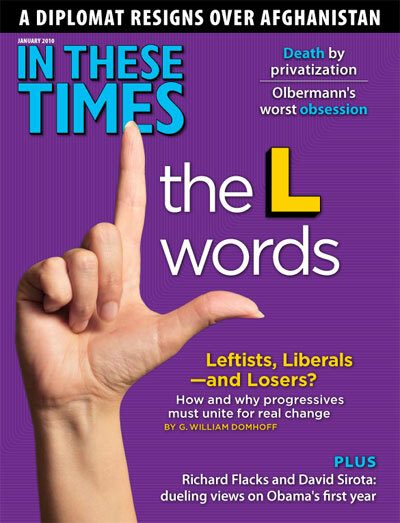Leftists, Liberals—and Losers?
How and why progressives must unite for real change.
G. William Domhoff

As President Barack Obama’s first year in office draws to a close, perhaps most In These Times readers feel the same way I do – more disappointed in the new administration and the Democratic Congress than I expected to be, even as I recognize dramatic changes since the Bush administration departed. Yet, I am even more disappointed that we on the left (progressives, socialists, anti-corporate capitalists) seem to be missing opportunities to change the direction of our country.
Those of us who seek progressive social change in the United States have made few advances in recent decades. This dearth of progress comes after a wealth of earlier successes: the organization of industrial unions, the creation and triumphs of the civil rights movement, and the successes of the feminist, environmentalist, LGBT and living-wage movements.
One cause of our current lack of accomplishments is an impasse between the two main political forces working for social change – Democratic liberals and leftist progressives – who differ in both goals and strategies. Liberals support gradual changes through education, lobbying and elections to curb the worst excesses of our capitalist system and provide greater social benefits through government. Leftists argue for more radical changes to the status quo.
Rather than lament the failures of the Democrats in Washington or the past failures of leftists, I want to offer a concrete strategy for creating the change we all want. In this more hopeful post-Bush/Cheney era, it is time to figure out how these two forces can rethink their strategies and create a coalition that could transform the nation.
Why don’t leftists connect with very many people, even though most Americans support greater equality, jobs for all, government support for education at all levels, government health insurance and much more? Maybe the problem is in the solutions the left offers and the way we’ve framed them, rather than people’s unwillingness to support greater fairness and equality. To overcome our relative marginalization, American leftists should create a strong new alliance with our more numerous brethren – the approximately 20 percent of Americans who define themselves as “liberal.”
Why an alliance? First, such an alliance might influence centrist Democrats in Washington if it could garner strong support from the Democratic base. Second, an alliance would have a chance to reach the American electorate’s great middle, including independents who turned on the Republicans in 2006 and 2008 because of the failure of the Iraq War and the rapacious destruction of the economy by the financial sector.
If the wars in Iraq and Afghanistan continue to produce failure and American casualties (as is entirely likely), and if the Obama administration is unsuccessful in its efforts to deal with the current health, financial and employment crises (as looks increasingly likely), then a liberal-left program backed by nonviolent social disruption would resonate with those in the middle who have lost their jobs, homes, and/or life savings. This alliance would require progressives to make major changes in strategy, but not in values and goals; liberals would have to recognize that a constitutional democracy has room for far more economic egalitarianism than America has ever seen.
For liberals and leftists to successfully make change together, they must first reach an understanding, if not agreement, on four major areas:
electoral strategy
the crucial role of social movements
the need for innovative economic models
the definition of “us” vs. “them”
Here is a step-by-step approach for helping liberals and progressives find common ground. I am proposing a way for leftists to cooperate with liberals to generate short-term advances while at the same time competing with them for the allegiance of the majority to a strong egalitarian vision. In doing so I am claiming the fault is not in our values, but in our strategies. I am suggesting a “liberal egalitarianism.” Yes, it’s a long shot, but thinking big is worthwhile in moments of great crisis.
SO YOU WANT TO WIN AN ELECTION
The structure of a nation’s political party system influences how social change occurs. This country’s two-party system renders third parties far smaller and more ephemeral than in other democracies. Yet many progressive activists opt for third parties. The problem goes beyond the issue of leftist candidates becoming “spoilers.” Worse, it creates divisions among all those who are left of center and enables the election of conservatives, who are most insensitive to the needs of low-income people, people of color, women, environmentalists and religious minorities.
Further, progressives often fail to realize their power to influence the existing parties by challenging their platforms during the primaries. The gradual development of party primaries in the first 60 years of the 20th century led to the demise of the Democratic and Republican parties in the old sense of the term, with the power to expel members and pick their own candidates. The two major parties are now government-controlled pathways into elected government office. Anyone can register to be a member, and anyone can run in the primaries. Winners in the primaries put their coworkers into leadership positions in the party.
Progressives need to take advantage of the power this situation offers, rather than reject the two-party system. Party primaries open the way for leftists and liberals to disagree within the political arena while moving the Democratic Party in their common direction. Progressives at the state, congressional, district and local levels should form their own democratic clubs within the Democratic Party – essentially parties within the party – that would give them an organizational base and a distinctive social identity in the political arena. For example, in Michigan, a group of progressives who met through MoveOn house parties established Harbor Country Progress, an official Democratic Party club that is changing the political landscape in the state’s rural 6th Congressional District. (See “Building the Left in Harbor Country” by Jim Vopat, ITT, October 2009.)
Forming such clubs allows activists to maintain their primary social and political identities while at the same time enabling them to compete within the Democratic Party. They can run candidates on strong progressive platforms in the primaries if and when the issues, circumstances and candidates seem right. They would campaign to win on the basis of our program and make no personal criticisms of their Democratic rivals. (Yes, corporate Democrats will outspend leftist Democrats, but this will happen whether leftists run in third parties or Democratic Party primaries.)
Should they lose, they would still back the winner of the primary in the general election. Being seen as a loyal Democrat is essential to gaining the confidence of the Democratic electorate and eventually transforming the Democratic Party itself.
This does not mean progressive activists should drop their many current social movement efforts and focus their energies on electoral politics alone. But electoral politics are essential to any program for progressive social change. Insisting on sticking with third parties or ignoring the electoral process ensures failure.
SPARKS, CRACKS AND SOCIAL MOVEMENTS
Social movements are necessary for social change. They help mobilize the electorate. A handful of dedicated activists can provide the spark to find cracks and openings in the power structure, and develop ways to draw everyday people out of their routines in order to make history. The key is finding the right strategy and focusing on an agenda that engages people at a particular moment.
Strategic nonviolence is the only form of disruption that makes any sense in an advanced capitalist democracy where most people accept the political norms of the society. According to polls, from the 1960s to the 1980s, the American public became more receptive to a wide range of issues championed by egalitarian movements, such as women’s rights. At the same time, most Americans disapproved of the anti-war movement, which employed violent and disorderly tactics. Thus the civil rights movement, not the anti-war movement, is the prototype of what is necessary and possible.
Today’s crises could – and should – catalyze new social movements. Some smaller current actions to prevent foreclosures, stop the abuse of workers and target health insurance companies show that civil disobedience can be effective. Sit-ins that close banks, insurance offices, healthcare offices or government offices could become the order of the day. The escalation in Afghanistan and/or the failure to leave Iraq might lead to anti-war actions in the face of mounting casualties that are destroying families across the nation for reasons that continue to be unclear and unconvincing.
Activists must once again be trained in strategic nonviolence. We also need new leaders who are as committed to civil disobedience as Martin Luther King, Jr. and César Chávez were.
Faced with the choice between seeing large numbers of people incarcerated or making major concessions, the Obama administration might abandon centrist economics and stand up to Blue Dog Democrats, rather than standing idle while local and state law enforcement officials descend into a predictable repressive cycle.
EGALITARIANISM THROUGH THE MARKET?
The importance of an alternative economic vision cannot be overestimated in understanding the success of past movements for progressive social change, especially in energizing left-wing activists.
Socialism was once such a vision, with a foundation in government ownership of the means of production and centralized planning. But the past 60 to 80 years have shown that this alternative cannot work in an egalitarian and democratic way. Even if government planners had enough information and the technocratic capacity to generate an optimal plan, and if democratic pressure was able to keep the bureaucracy from becoming elitist – two big ifs – the process would end up hierarchical and nonparticipatory. That’s because information goes upward and orders and commands flow downward in such a system, as the libertarian socialist economist Robin Hahnel shows in his seminal book Economic Justice and Democracy (2005).
The failure of socialism worldwide has left egalitarians without a vision of a better economic model since the 1980s. But the implosion of the American economy demonstrates that a free-market approach is deeply flawed, and those who continue to put their faith in the market are as delusional as their counterparts who support central planning.
I suggest leftists think in terms of a fact that has been overlooked until recent years. Markets can be socialized to serve collective purposes by using four well-known policy tools as carrots and sticks: subsidies, taxes, government purchases and regulations. That is, there can be conscious and planned interventions in the market in the name of greater equality and participation. I contend that this is a form of planning that makes use of markets even though some of their more dangerous qualities would not be fully tamed. It is a form of planning that the current American government has the power and experience to institute through Congress and a variety of government agencies.
The best example of how the government currently shapes markets concerns the annual battle in Congress between heavy industry and environmentalists over energy policy. Environmentalists call for higher taxes on fossil fuels, subsidies for renewable energy sources and regulations that force automobile manufacturers and utilities to burn fuels more efficiently and cleanly. The oil, coal, automobile and utility companies demand low taxes on fossil fuels, subsidies for fossil fuels and minimal or no regulations relating to efficiency or pollution, which in effect is a very different plan. If the environmentalists’ plan were to prevail, the United States could gradually wean itself from foreign oil and clean up the air and water at the same time.
The answer is not to be found in economics, but in politics. It is a matter of who has the power. Once the left accepts that there will be markets and private property, all the talk about the sanctity of markets become a rationale elites use to maintain their privileges.
Taming the market through collective action is the basic strategy of living-wage campaigns, which use laws to force employers to pay higher wages. Laws regarding affirmative action, sexual harassment and discrimination also operate through the market. The real issue, again,is political power.
A reconstructed market system – featuring a more progressive tax structure, higher inheritance taxes and a transaction tax on financial trades –could be much more open and flexible than the one that currently exists in the United States. For example, it is possible to have many different types of enterprises compete in the market, not just privately owned corporations. There could be a combination of cooperatives, state-owned companies, and private companies – a “mixed enterprise system,” to recycle an old phrase.
Although this program does not build on libertarian socialists’ economic ideas, in which markets are eliminated, it does fit with their emphasis on the need for socialists to work within reformist coalitions to help move things in a leftward direction. If their political approach were adopted by all leftists attracted to a form of socialism, then everyone, including liberals, could be focused on winning the power to legislate the changes that might make more radical change more attractive to voters further down the line.
For now, it’s time for leftists to think in terms of a new vision: socializing and taming markets through many different types of government interventions.
REFRAMING US VS. THEM
Social movements use an “us” vs. “them” framework to mobilize opposition to existing power arrangements. However, any framing of “them” that uses categories from which individuals cannot escape – social class of origin, race, gender or sexual orientation – is a mistake that creates a self-fulfilling prophecy and overlooks the possibility that people can change their minds.
Although the power structure in a capitalist society revolves around classes and class conflict, it does not follow that political conflict should be framed in terms of social classes or class struggle. Political conflict should be framed in terms of values, coalitions and power – not class.
Again, the civil rights movement provides a model. The enemy was defined as racists and bigots, not whites in general. The movement was able to use the Christian concepts of forgiveness, redemption and conversion in the service of strategic nonviolence to forge a black/white coalition. Thus people were able to change their attitudes and join the movement. They weren’t excluded on the basis of being white.
Since a cross-class coalition is necessary to assemble a majority for an egalitarian economic program in the 21st century, it is better to begin with a political framing of the “us” vs. “them” issue that does not define one class or another as the enemy. Instead, the opposition should be all those who favor pro-corporate policies and fight against the program of the liberal-left alliance. If the conflict is framed in this way, a liberal-left alliance has a chance to win over the moderates, neutrals and independents who currently identify with corporate capitalists. It might even attract dissident members of the capitalist class who transcend their class interests, and in the process help legitimize the movement to those in the middle who are hesitant to climb on board.
THE CHALLENGE FOR LIBERALS
It is my belief that today’s liberals might find this framework a useful one for their own purposes. They might agree that the energy and dedication leftists bring to the alliance through their social movements help to make possible what later become liberal legislative victories. They also might agree that it would be a fair trade to accept competition in Democratic primaries from leftists if leftists completely abandoned potentially divisive involvement in third parties and put some of their energies into regular elections as well.
Based on the past liberal emphasis on the importance of private property and minimal government interference in the workings of the economy, taming the market in a major way through government intervention, along with public ownership of some enterprises, might be difficult for many liberals to accept. However, as the liberal sociologist Douglas Massey forcefully argued in The Return of the “L” Word (2005), markets should be very heavily “policed” by government. His argument is noteworthy because it suggests a narrowing of the gap between leftists and liberals when it comes to creating a more egalitarian economy through government intervention. Moreover, many modern-day liberals agree to a mix of ownership forms as long as there are clear protections for private property.
None of the points in this article is original, but they add up to a program that has never been tried, a program that many liberals might support. It unites electoral and non-electoral strategies, bypasses the structural impossibilities of third parties and non-market centralized planning, reaffirms the importance of social movements, and provides an “us” vs. “them” framing that allows people to change their minds and thereby join what could become a new majority.
Today, the large bloc of Southern and rural non-Southern Democrats that stopped or moderated liberal initiatives in the 1930s and 1960s is down to a nub in Congress. Unemployment and foreclosures are predicted to remain high for at least two years due to an economic crisis that may not be solvable without liberal economic policies that will involve increasing government intervention in the economy. The unnecessary and unwinnable war in Afghanistan is causing increasing casualties and will cost trillions of dollars if it continues for very long. The high expectations created by the election of Barack Obama and large Democratic majorities in Congress are dissipating rapidly. And Americans know from experience – and a look at other countries – that many changes in the economy can be carried out democratically and without loss of freedoms.
Liberals and leftists have had new opportunities in the past, but they never have had one this good.






